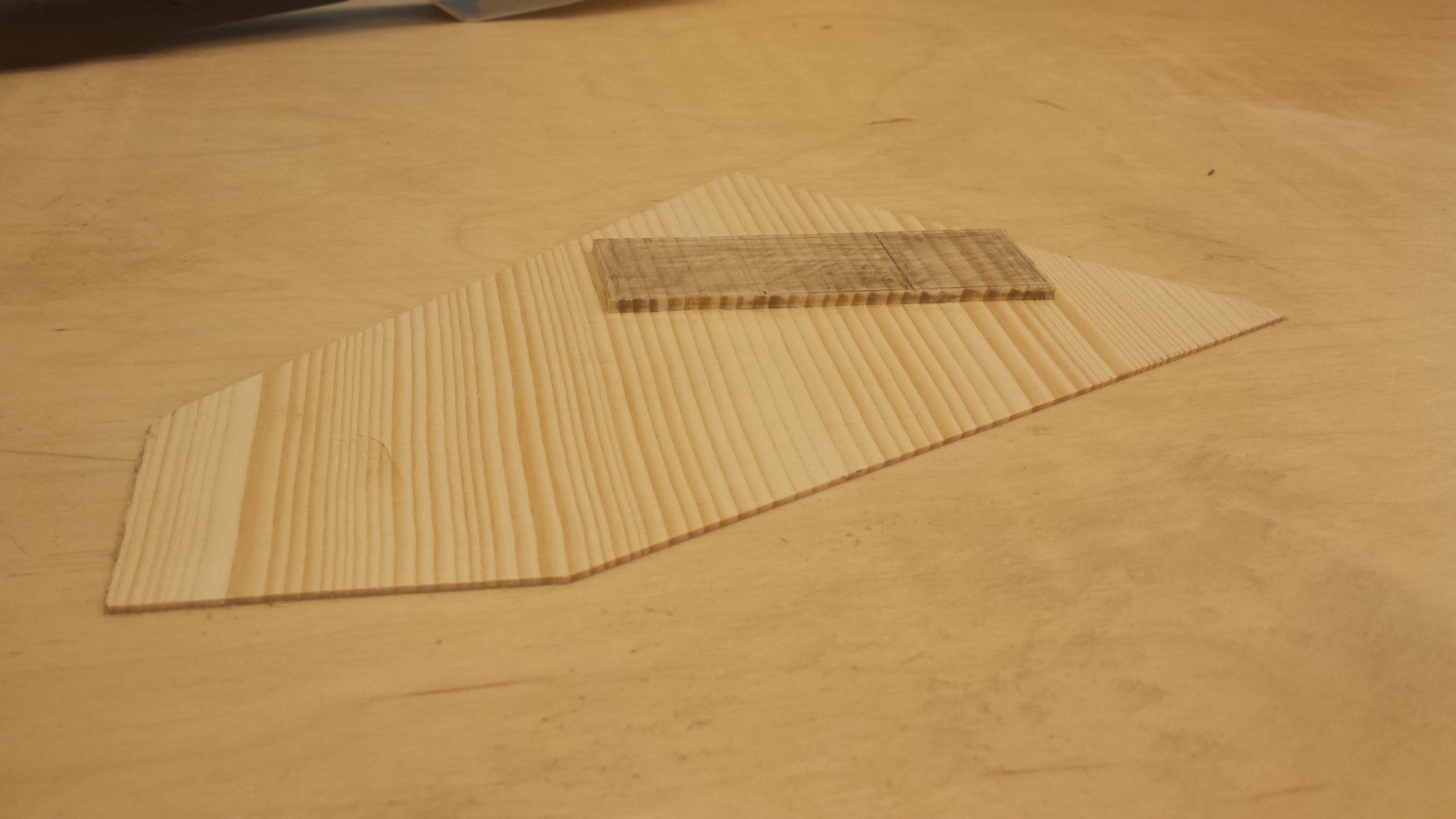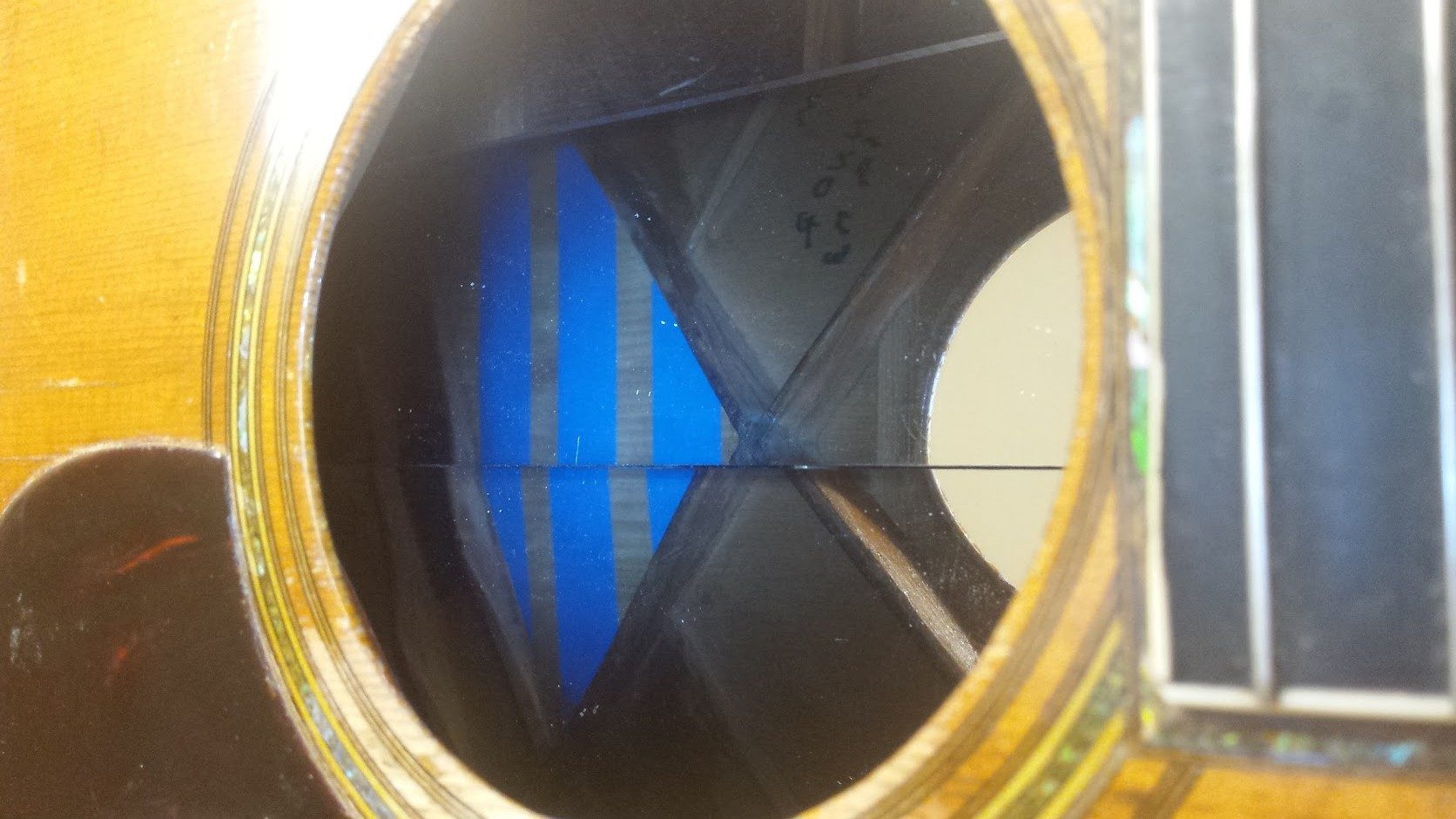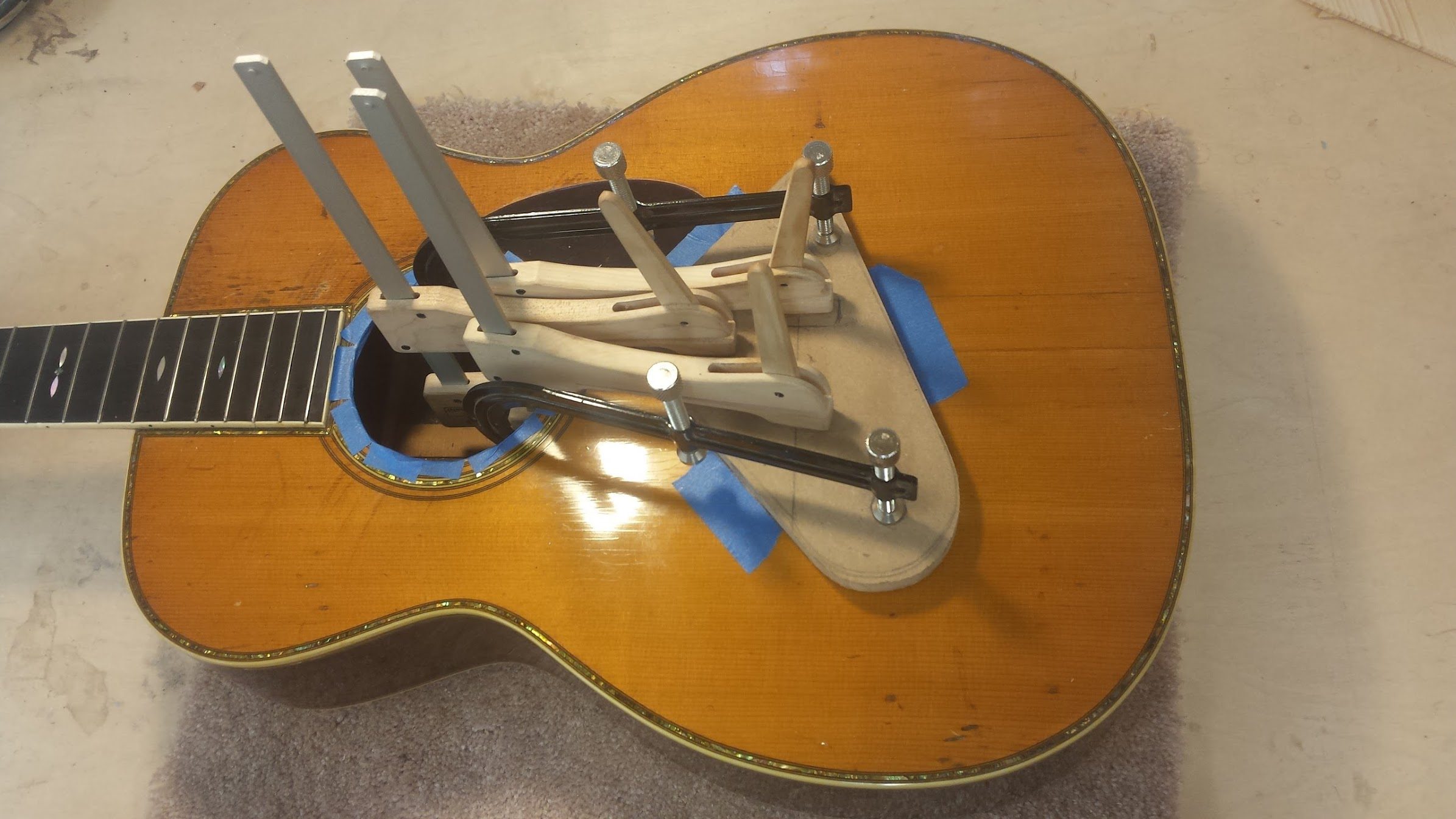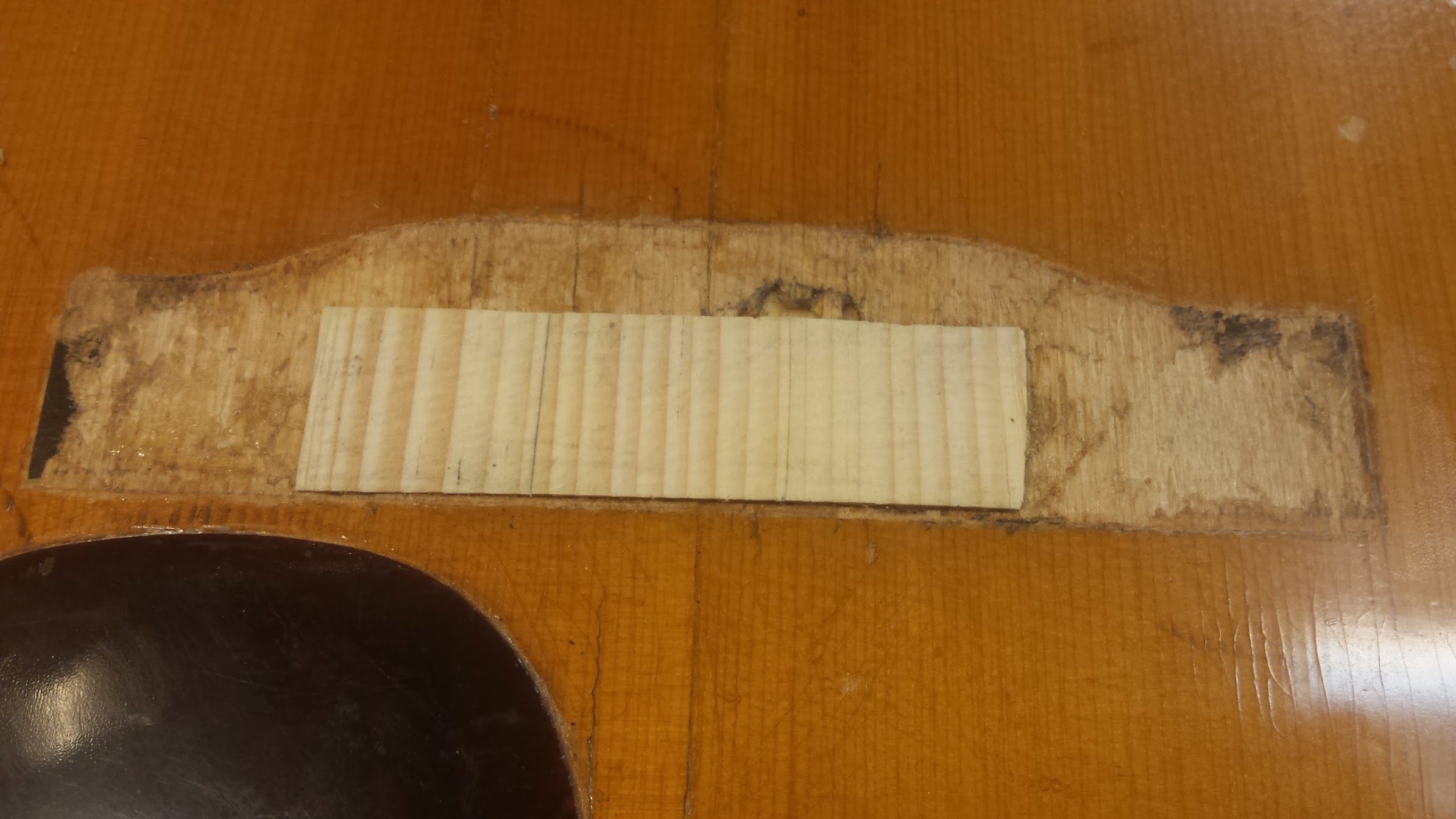We recently signed up with French-born luthier Benjamin Paldacci after having met him at the Woodstock Luthier Invitational, and we wanted to get a little better acquainted with the man behind the chisel, so to speak. We’ve had a Malaysian Blackwood OM of his that’s already sold (couldn’t keep it on the rack long enough to gather a speck of dust), and we’re excited to start working with him on the next one. Here’s a link to that OM to tide you over until the next one comes along: https://www.dreamguitars.com/shop/new-paldacci-om-malaysian-blackwood-carpathian.html. See below for our chat with Benjamin!
LW: For starters, why did you leave your home country of France to study at the National School of Lutherie in Quebec City?
BP: I grew up in an artistic family. My parents were psychoanalysts (my mom) and in the human-resource world (my dad), but we were listening a lot of music from Classical to Blues, Rock, or French-variety. Our parents encouraged my sisters and I to draw, to play an instrument, or anything that we would love. At 19, I decided to learn how to play guitar, and as I was afraid of hurting my fingers, so I started to play electric guitar, not classical or acoustic. Yeah, I know, it is not traditional at all, but well, the principal reason is that I was fond of Led Zeppelin, The Beatles, Hendrix, Pink Floyd…that kind of stuff. And I learned that even with electric guitar…your fingers hurt…so bad, ha!
 So, when I graduated from high school, I started post-diploma courses, but it was not my thing…at all. It had nothing to do with guitar building, and I was not happy about it. So, I quit and I decided to find a professional way to pursue what I love. I wanted to set up my electric guitars for me and my friends, and the best way to do that was to find a master for an apprenticeship, or a school. I didn’t want to stay in France, so I started to research where to find a proper school outside of my country.
So, when I graduated from high school, I started post-diploma courses, but it was not my thing…at all. It had nothing to do with guitar building, and I was not happy about it. So, I quit and I decided to find a professional way to pursue what I love. I wanted to set up my electric guitars for me and my friends, and the best way to do that was to find a master for an apprenticeship, or a school. I didn’t want to stay in France, so I started to research where to find a proper school outside of my country.
Roberto Venn, Bryan Galloup, Newark School, there are plenty of great ones in the world, but back in the days, my English was terrible (well it is way better right now, but I still need to improve myself about that). Fortunately, I saw that there were two schools in Canada where they spoke French, at Quebec, Montreal (Bruand School) & Quebec City (The National School of Lutherie). As I am not a fan of big cities, I decided to go with the second one. I applied to it, and they took me in 2009.
At the beginning, as I said, I wanted to set up instruments & build vintage guitar replicas (Les Paul, Stratocasters, Telecasters), but after two years of study, I totally changed my mind and said, “Damn son, you will be an acoustic-guitar maker!” and the story begins!
LW: Many builders have a particular guitar or maker that has heavily influenced their body of work. Do you have an archetype of your own?
BP: In the third year at my school, we needed to design our own guitar shape. We had the luck to have an AutoCAD course, one of the best things my school provided to us IMHO. So, I started to research it, and I discovered the work of Michihiro Matsuda. It totally blew my mind, and I was like, “But…how is it possible to have this kind of approach on an instrument?!” I have always been a fan of design (Philip Stark especially) in architecture, sculpture, and cars since I was a boy. My father told me that when I was three years old, I was able to tell the brand of each car in the street. So, Michihiro’s work was a blast for me.

 I am not sure if I have an archetype, properly, but I have a philosophy. Of course, my principal inspiration comes from my mates in the lutherie world, but as a craftsman, I try to find inspiration in whatever I see in my life. It could come from a dollmaker, watchmaker, from a furniture restorer or an insect. I think that craftsmanship is a whole thing, like a gigantic tree with tons of branches, and I am one of its tiny buds. Leonardo DaVinci definitely is a good example of what I am talking about: he was a man of many talents who mastered so many things with one thing in mind: curiosity.
I am not sure if I have an archetype, properly, but I have a philosophy. Of course, my principal inspiration comes from my mates in the lutherie world, but as a craftsman, I try to find inspiration in whatever I see in my life. It could come from a dollmaker, watchmaker, from a furniture restorer or an insect. I think that craftsmanship is a whole thing, like a gigantic tree with tons of branches, and I am one of its tiny buds. Leonardo DaVinci definitely is a good example of what I am talking about: he was a man of many talents who mastered so many things with one thing in mind: curiosity.
LW: Who are some of your favorite guitar players? Have you built instruments for any of them?
BP: In the modern electric guitar world, John Mayer definitely is one of my favorite players. Unfortunately, Mike Bloomfield passed away, but he clearly is, for me, one of the most powerful symbols of the old times. In the Acoustic world, Tony McManus definitely is one of my most favorite musicians. When he stopped at my booth during the Santa Barbara 2016 show (SBAIC) and played one of my guitars, it was a blast for me, probably one of my best memories since I became a luthier. You know the guitar he played, because you had it in your shop. It was the Malaysian Blackwood OM (https://www.dreamguitars.com/shop/new-paldacci-om-malaysian-blackwood-carpathian.html). It would be a dream to build a guitar for that kind of incredibly gifted musician, but their guitar collection is well provided. But we never know how life could turn out!
LW: Talk to me about your current shop arrangement. How do you manage workflow? Photos are welcome.
BP: Having a workshop is complicated because of all the machinery I have. I had the luck to find a good place to stay in Quebec city, in a peaceful and green spot. As do a lot of us, I basically live in my shop, it is part of my apartment. One of the great thing about that, is when you sand some aromatic pieces of wood, all your apartment smells incredibly good. I am especially thinking about African Blackwood. But it’s a cursed when it’s time to sand a piece of bone!

As you could see in the photos I sent over, I have a basement and two rooms for the workshop. The first one is dedicated to wood and parts storage, hand tools and stuff. It is wood dust free (well, I am using a jointer and a drill press in it, so let’s call this place the minimum dust room). It allows me to assemble my instruments, glue some things with a Hot Hide Glue, fix a setup, or to french polish easily. Plus, I have two windows which give me a wonderful light. It is very important for my eyes. Nothing is worse than working with a candle as only source of luminosity.
The other room is dedicated to woodworking with a bandsaw and drum sander. I am working a lot in this room, and it is one of the most important of the three because I calibrate all my pieces in it. The basement is the third place, where there is the most dust, because my compressor and sanding machines are there. It is not a sexy place, I must admit, and I generally get out of it covered of wood dust, but that is one of the most amazing feelings for me. I am really carefull about my health, so I have two big dust collectors which work perfectly and protect me from it [the dust]. As you can see, I don’t have a booth to shoot finish because I don’t have the room for it. That’s why I send my guitars somewhere else for this step (polyester UV-cured finish). I can do french polish, but it is very fragile (but beautiful though).
LW: Please describe your approach to voicing an instrument. How did you first find your voice, and how do you continue to experiment?
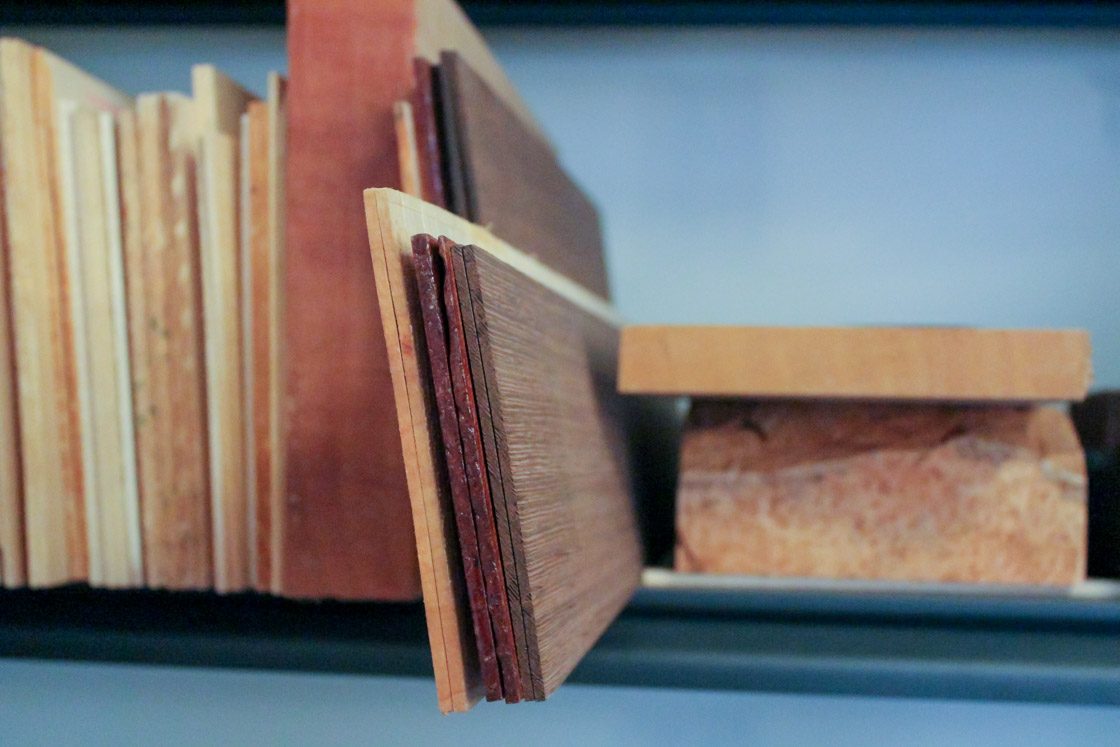 BP: Well, Ervin Somogyi’s book was at the origin of my voicing philosophy. I build my guitars lightly but strongly, as responsive as possible. For me, the top and back of the guitar work like a drum. That’s why they are thin, with high and light bracing (I carve it to obtain this result). I am using, principally, the deflection test to get the result I want, but I am working with my instincts: I touch the wood, I twist it, weigh it, and I use the tap tone a lot.
BP: Well, Ervin Somogyi’s book was at the origin of my voicing philosophy. I build my guitars lightly but strongly, as responsive as possible. For me, the top and back of the guitar work like a drum. That’s why they are thin, with high and light bracing (I carve it to obtain this result). I am using, principally, the deflection test to get the result I want, but I am working with my instincts: I touch the wood, I twist it, weigh it, and I use the tap tone a lot.
For the soundboard, I love the double X bracing because it allow me to have the balance and homogeneity I want for my guitars. When I am using a more traditional bracing pattern, I still modify it to reach the result I want. My backs are active, three or four tonebars. It depends on the result I want. Again, each piece of wood are different, so I work with each of them differently. They need to work in harmony, and this is what I am trying to push myself toward day after day. As Socrates said, “I know that I know nothing,” and when I see incredible guitars my colleagues build, I know that it is my motto.
LW: What’s on your bench right now? Any new design features you’d like to share?
BP: As I am going to Vancouver International Guitar festival (VIGF) in August, and Woodstock Invitational Luthier Showcase (WILS) in October, I am pretty busy. Six models:
OO-12 Higuerilla/Lutz
OM Higuerilla/Carpathian
OO-12 Honduran Mahogany Old Growth/Lutz
OO-12 African Mahogany/Engelmann
OM Claro Walnut/Sitka Bearclawed
Grand Auditorium Wenge/Red Spruce.
This last model is pretty special for me, because I designed it especially for WILS. I wanted to design this shape for a long time because a lot of my mates have this shape in their catalog, and it is a perfect way to make the transition between my OMs and my Dreadnoughts.
 I have two guitars for customers I will receive back from my finisher soon. A Flamenco Spanish Cypress & Carpathian Spruce (new shape), and an OM in Koa and German Spruce.
I have two guitars for customers I will receive back from my finisher soon. A Flamenco Spanish Cypress & Carpathian Spruce (new shape), and an OM in Koa and German Spruce.
LW: What music are you listening to right now?
BP: The last Foo Fighters album, Concrete And Gold. I just love this group, their approach and their attitude. It is pretty rare to have such an incredible leader like Dave Grohl these days. This person is authentic, an incredible drummer, and an awesome composer/entertainer. I saw them two weeks ago at the Festival D’Été de Québec: best show in my short life. I tried to approach them to let them play my instruments backstage, but as I supposed, it was incredibly difficult, and impossible. So, guys, if you are reading this interview…
LW: There’s a lot of competition in the fine lutherie market. In your eyes, what sets your guitars apart from the pack?
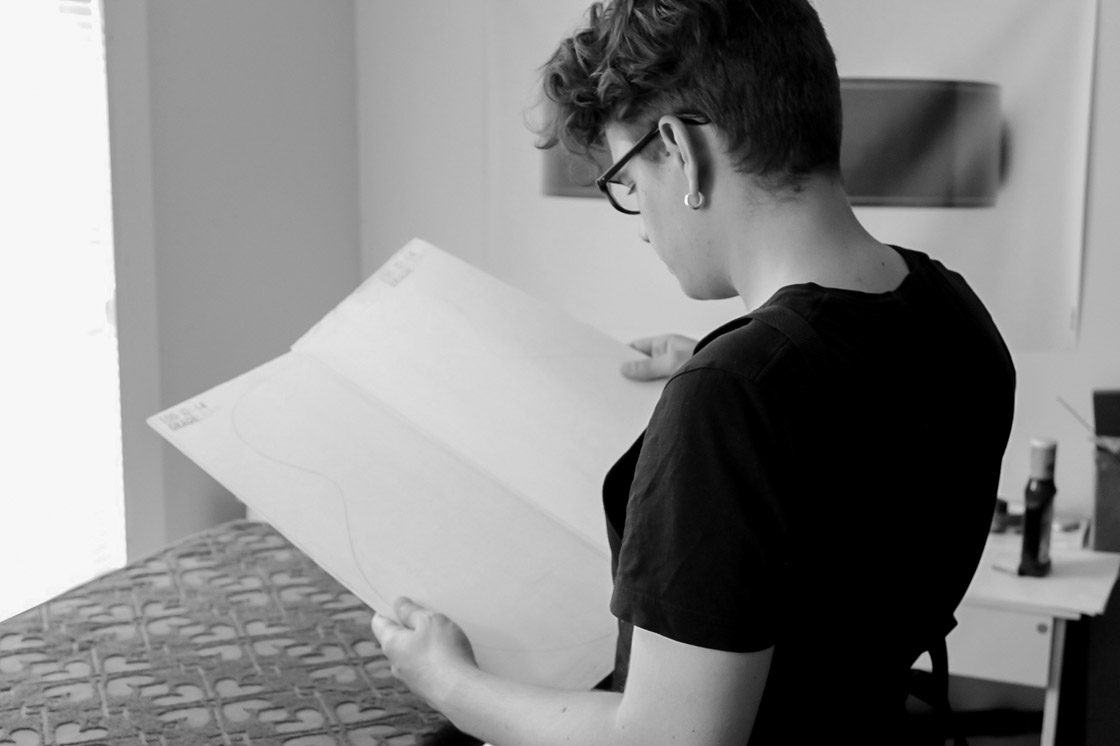 BP: Well, our market is definitely competitive, because a lot of us are incredibly gifted, and new builders are coming every years. But we all are in the same boat, and our community is super helpful and full of kind people. I’ve had tons of great experiences and good relationship with my colleagues, and when someone needs help I try to be there for them. In the contemporary world, the word “competitive” is only half appropriate because we all build instruments in a very personal way. My philosophy is, “I strive to build my instruments with the finest Tone, Ergonomics, & Aesthetics.” I call the rosette/headstock/endgraft the Holy Trinity because they are a huge part of my identity in terms of style. I love Art Deco, and I try to explore this style with marquetry techniques and the color/texture of the wood. It is incredibly fun for me to push myself a little in terms of craftsmanship, guitar after guitar. My sound is, of course, my main goal. I always keep in mind a certain balance, clarity, and definition for each string. I love when my high frequence shine with, of course, a strong 6th string presence too.
BP: Well, our market is definitely competitive, because a lot of us are incredibly gifted, and new builders are coming every years. But we all are in the same boat, and our community is super helpful and full of kind people. I’ve had tons of great experiences and good relationship with my colleagues, and when someone needs help I try to be there for them. In the contemporary world, the word “competitive” is only half appropriate because we all build instruments in a very personal way. My philosophy is, “I strive to build my instruments with the finest Tone, Ergonomics, & Aesthetics.” I call the rosette/headstock/endgraft the Holy Trinity because they are a huge part of my identity in terms of style. I love Art Deco, and I try to explore this style with marquetry techniques and the color/texture of the wood. It is incredibly fun for me to push myself a little in terms of craftsmanship, guitar after guitar. My sound is, of course, my main goal. I always keep in mind a certain balance, clarity, and definition for each string. I love when my high frequence shine with, of course, a strong 6th string presence too.
LW: If you had not become a guitar maker, where do you think life would have led you?
BP: Cooking is one of my hobbies, and food is one of my favorite ways of life! I think I would tried to work in a kitchen if I was not a luthier. But we’ll never know! As I said once, “Building a guitar is just like being a master chef: you need to use the best ingredients to create the best result possible. Skills, experience, vision, and precision are all fundamentals in the making of a wonderful instrument.” I have nothing else to say. Thank you for this interview, I really enjoyed it and it is a privilege for me to be at Dream Guitars. The Malaysian Blackwood OM was a beautiful experience, and I’m glad to know we can do it again!
We can’t wait to see what rolls off his bench next, and if you’re like us you can hardly wait to see it!























 LW: I’d like to start with an obvious question. Why guitars? What first drew you to build these instruments?
LW: I’d like to start with an obvious question. Why guitars? What first drew you to build these instruments?

 At heart I’m a singer-songwriter fan and I’ve had the privilege of building guitars for some of my modern heros. Barton Carroll is one of the best songwriters out there and quite the guitar player to boot (listen to his song “Every Little Bit Hurts” if you want prime examples of both)! I was also able to deliver a guitar to Al James whose knockout songwriting was the driving force behind his band Dolorean for many years. The band broke up a few years ago, but I selfishly hope that a new guitar might inspire some new recordings in the future!
At heart I’m a singer-songwriter fan and I’ve had the privilege of building guitars for some of my modern heros. Barton Carroll is one of the best songwriters out there and quite the guitar player to boot (listen to his song “Every Little Bit Hurts” if you want prime examples of both)! I was also able to deliver a guitar to Al James whose knockout songwriting was the driving force behind his band Dolorean for many years. The band broke up a few years ago, but I selfishly hope that a new guitar might inspire some new recordings in the future!





























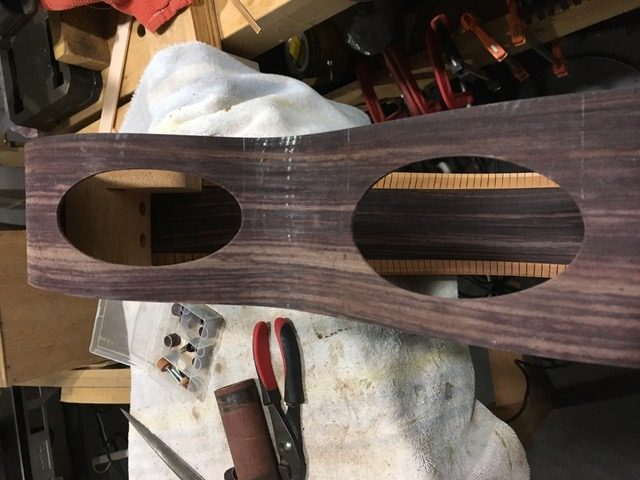

















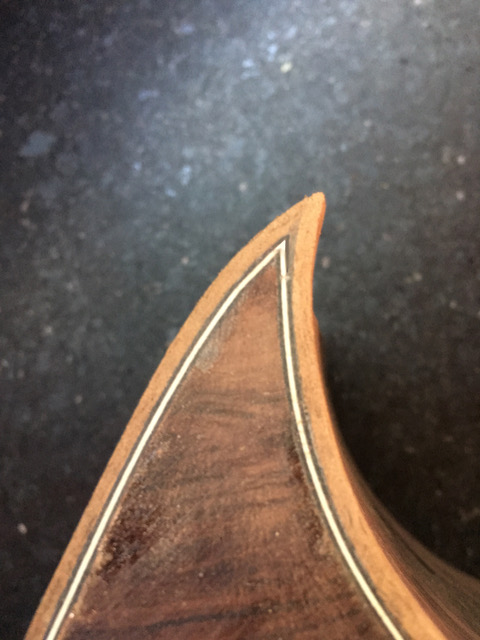






















 So, when I graduated from high school, I started post-diploma courses, but it was not my thing…at all. It had nothing to do with guitar building, and I was not happy about it. So, I quit and I decided to find a professional way to pursue what I love. I wanted to set up my electric guitars for me and my friends, and the best way to do that was to find a master for an apprenticeship, or a school. I didn’t want to stay in France, so I started to research where to find a proper school outside of my country.
So, when I graduated from high school, I started post-diploma courses, but it was not my thing…at all. It had nothing to do with guitar building, and I was not happy about it. So, I quit and I decided to find a professional way to pursue what I love. I wanted to set up my electric guitars for me and my friends, and the best way to do that was to find a master for an apprenticeship, or a school. I didn’t want to stay in France, so I started to research where to find a proper school outside of my country.
 I am not sure if I have an archetype, properly, but I have a philosophy. Of course, my principal inspiration comes from my mates in the lutherie world, but as a craftsman, I try to find inspiration in whatever I see in my life. It could come from a dollmaker, watchmaker, from a furniture restorer or an insect. I think that craftsmanship is a whole thing, like a gigantic tree with tons of branches, and I am one of its tiny buds. Leonardo DaVinci definitely is a good example of what I am talking about: he was a man of many talents who mastered so many things with one thing in mind: curiosity.
I am not sure if I have an archetype, properly, but I have a philosophy. Of course, my principal inspiration comes from my mates in the lutherie world, but as a craftsman, I try to find inspiration in whatever I see in my life. It could come from a dollmaker, watchmaker, from a furniture restorer or an insect. I think that craftsmanship is a whole thing, like a gigantic tree with tons of branches, and I am one of its tiny buds. Leonardo DaVinci definitely is a good example of what I am talking about: he was a man of many talents who mastered so many things with one thing in mind: curiosity.

 BP:
BP: 
 I have two guitars for customers I will receive back from my finisher soon. A Flamenco Spanish Cypress & Carpathian Spruce (new shape), and an OM in Koa and German Spruce.
I have two guitars for customers I will receive back from my finisher soon. A Flamenco Spanish Cypress & Carpathian Spruce (new shape), and an OM in Koa and German Spruce.
 BP: Well, our market is definitely competitive, because a lot of us are incredibly gifted, and new builders are coming every years. But we all are in the same boat, and our community is super helpful and full of kind people. I’ve had tons of great experiences and good relationship with my colleagues, and when someone needs help I try to be there for them. In the contemporary world, the word “competitive” is only half appropriate because we all build instruments in a very personal way. My philosophy is, “I strive to build my instruments with the finest Tone, Ergonomics, & Aesthetics.” I call the rosette/headstock/endgraft the Holy Trinity because they are a huge part of my identity in terms of style. I love Art Deco, and I try to explore this style with marquetry techniques and the color/texture of the wood. It is incredibly fun for me to push myself a little in terms of craftsmanship, guitar after guitar. My sound is, of course, my main goal. I always keep in mind a certain balance, clarity, and definition for each string. I love when my high frequence shine with, of course, a strong 6th string presence too.
BP: Well, our market is definitely competitive, because a lot of us are incredibly gifted, and new builders are coming every years. But we all are in the same boat, and our community is super helpful and full of kind people. I’ve had tons of great experiences and good relationship with my colleagues, and when someone needs help I try to be there for them. In the contemporary world, the word “competitive” is only half appropriate because we all build instruments in a very personal way. My philosophy is, “I strive to build my instruments with the finest Tone, Ergonomics, & Aesthetics.” I call the rosette/headstock/endgraft the Holy Trinity because they are a huge part of my identity in terms of style. I love Art Deco, and I try to explore this style with marquetry techniques and the color/texture of the wood. It is incredibly fun for me to push myself a little in terms of craftsmanship, guitar after guitar. My sound is, of course, my main goal. I always keep in mind a certain balance, clarity, and definition for each string. I love when my high frequence shine with, of course, a strong 6th string presence too.



















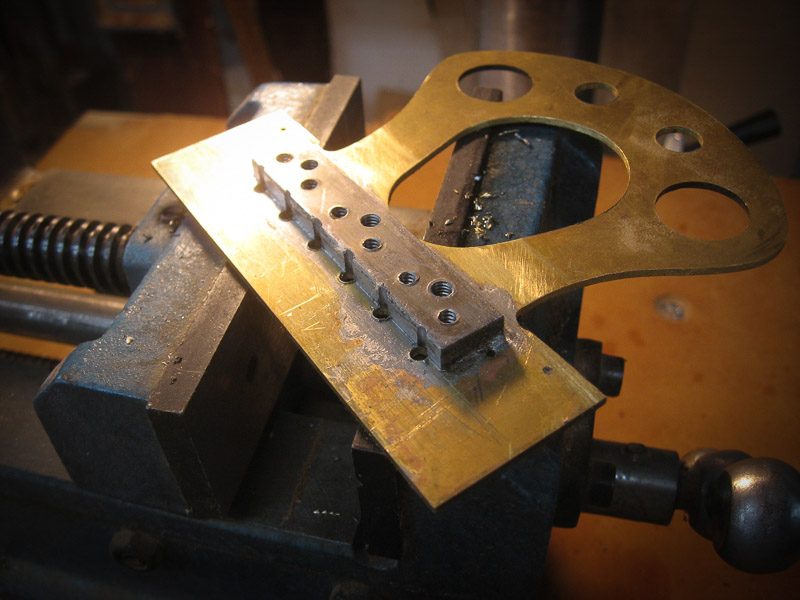

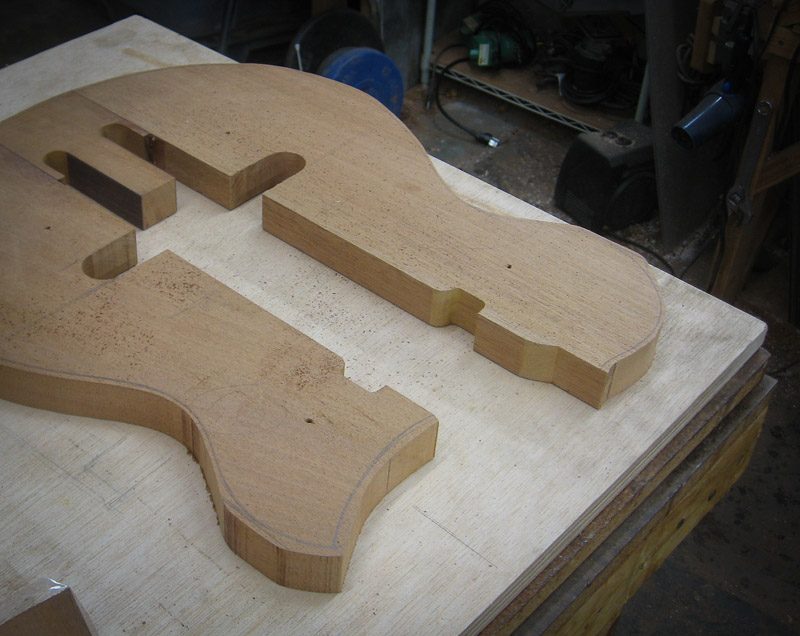



























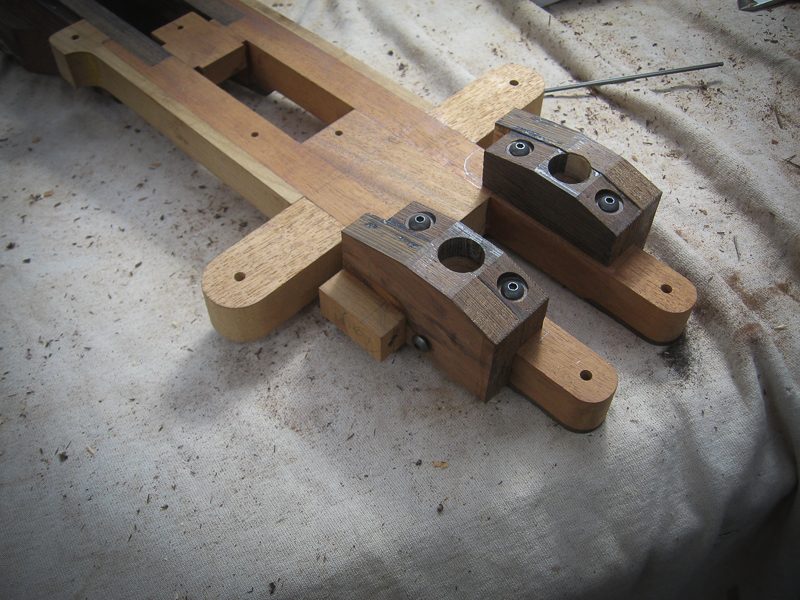





































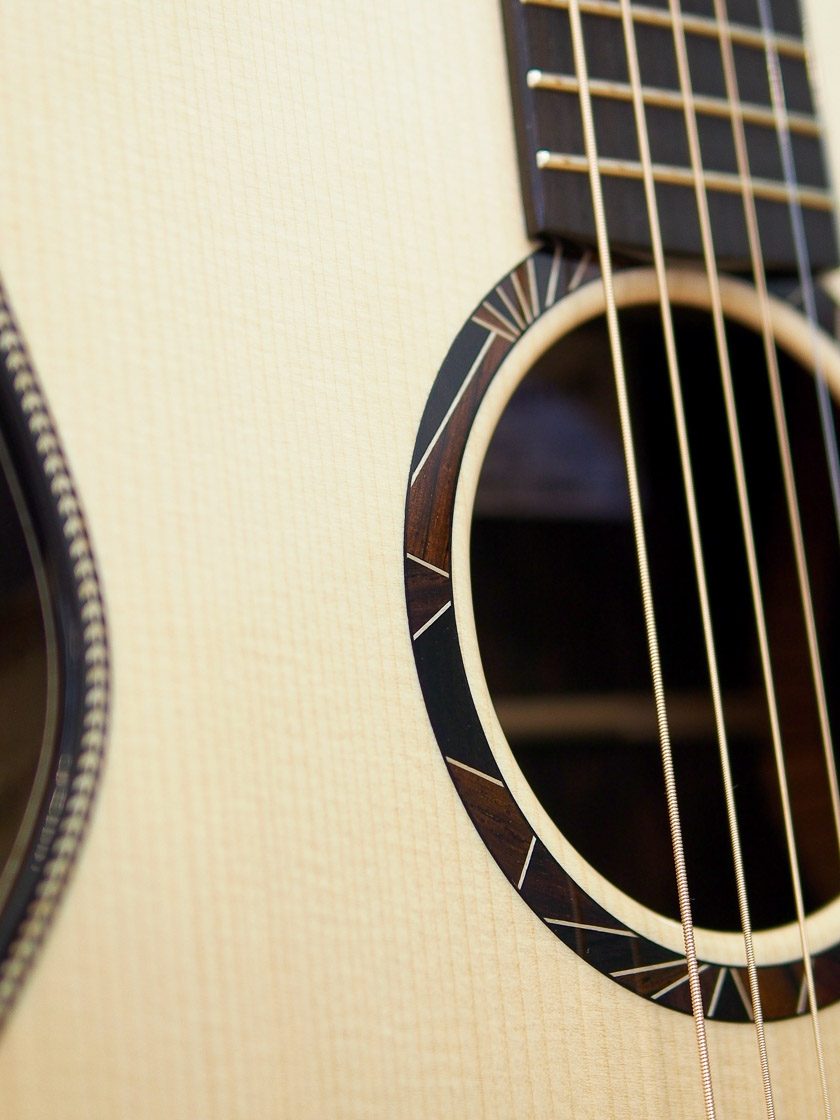

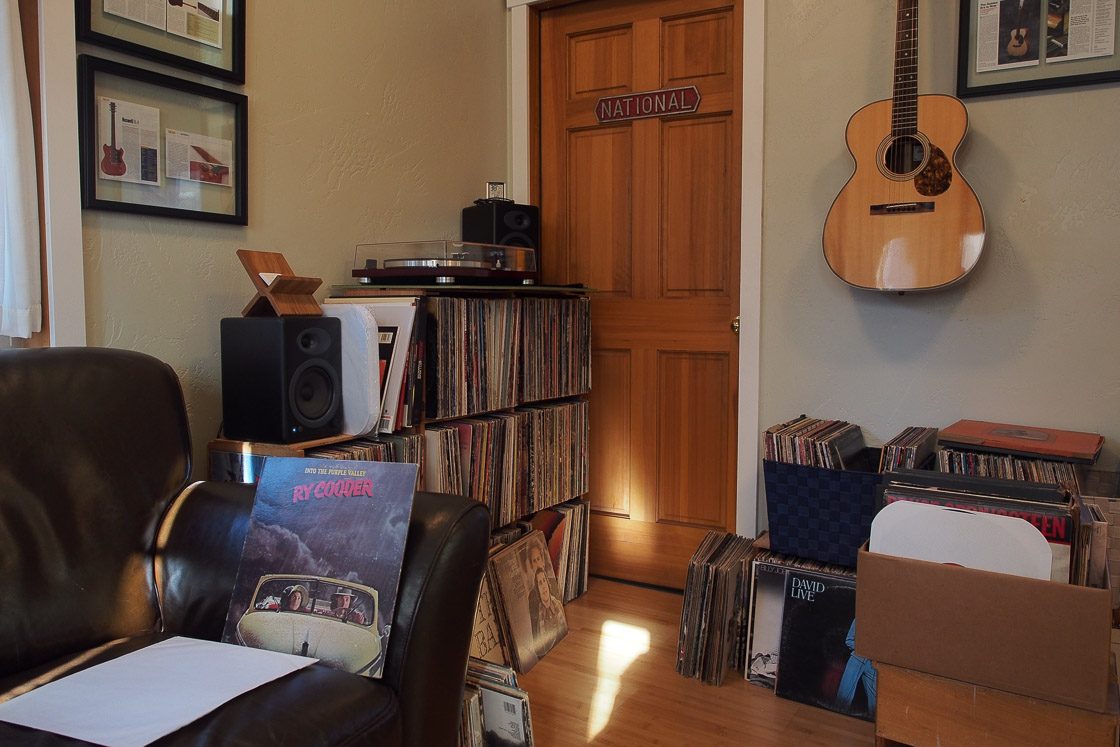
 BB: Like I said before, when I first got started with building, I was a repair guy, and really just copying what I had seen for years, both inside and out. But as I began to find truly inspiring materials, which wasn’t easy, and as I started to experiment with my own bracing ideas, my instruments started to sound more and more my own. I have tried various forms of voicing techniques, but the one thing that I always seem to come back to, the one thing that seems to never let me down, is my ear. I have worked in guitar shops and played music professionally for upwards of 25 years now. I always say that tone is the last thing for a player to learn. Developing one’s ear is not an easy thing to do. But,
BB: Like I said before, when I first got started with building, I was a repair guy, and really just copying what I had seen for years, both inside and out. But as I began to find truly inspiring materials, which wasn’t easy, and as I started to experiment with my own bracing ideas, my instruments started to sound more and more my own. I have tried various forms of voicing techniques, but the one thing that I always seem to come back to, the one thing that seems to never let me down, is my ear. I have worked in guitar shops and played music professionally for upwards of 25 years now. I always say that tone is the last thing for a player to learn. Developing one’s ear is not an easy thing to do. But, when you are subjected to it day in and day out for more than half of your life, inevitably it becomes somewhat engrained. When I first started building, I already knew what I was hearing when I would tap on a soundboard even before I could describe what was going on. Nine times out of ten, when I look inside of a production guitar, I see a very over-built instrument. They’re having to do that to protect themselves against warranty claims, but they’re also killing the tone of the instrument. Many things have led me to where I am today with the voice of my instruments (playing music, repairing, my education in engineering), but the one thing I know I can truly count on every time is my ear.
when you are subjected to it day in and day out for more than half of your life, inevitably it becomes somewhat engrained. When I first started building, I already knew what I was hearing when I would tap on a soundboard even before I could describe what was going on. Nine times out of ten, when I look inside of a production guitar, I see a very over-built instrument. They’re having to do that to protect themselves against warranty claims, but they’re also killing the tone of the instrument. Many things have led me to where I am today with the voice of my instruments (playing music, repairing, my education in engineering), but the one thing I know I can truly count on every time is my ear.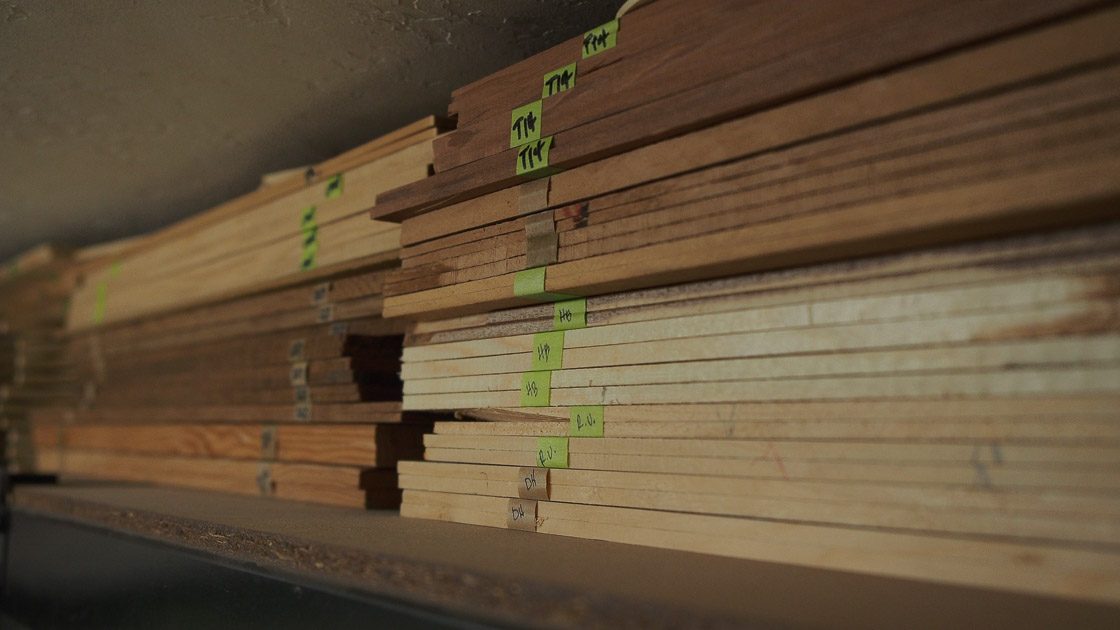
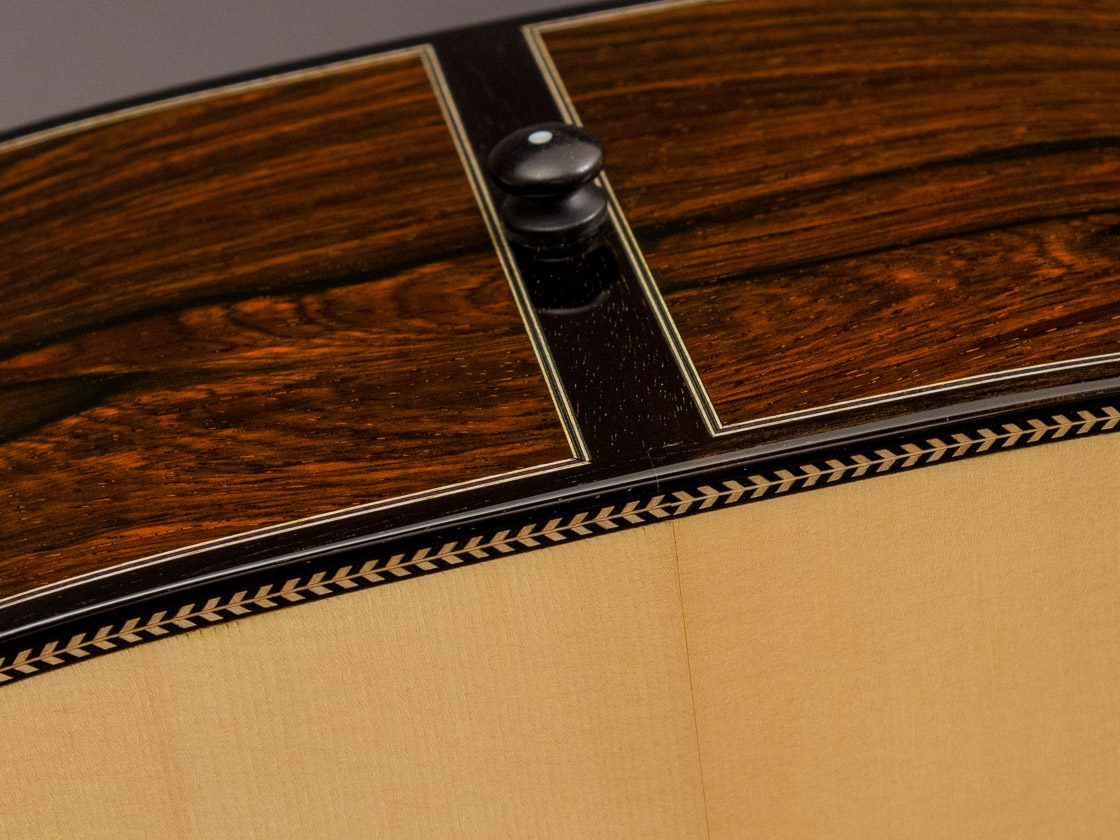
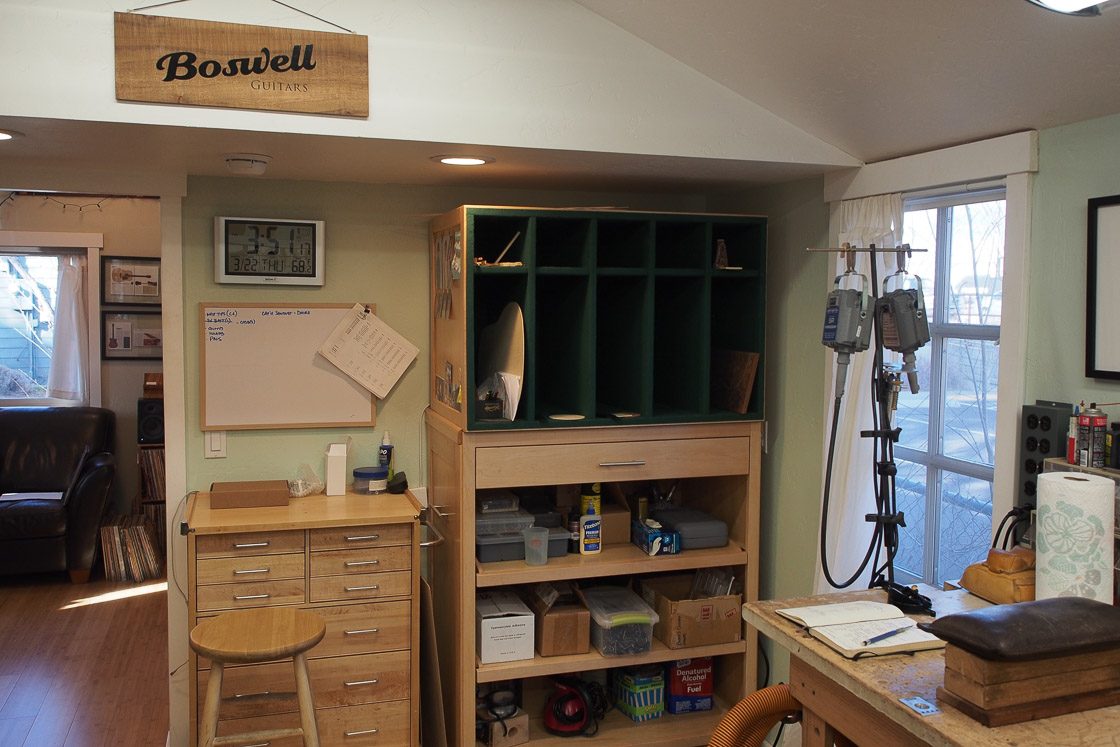



 CF: As a luthier working alone, I think it’s difficult not to experiment. When voicing an instrument I try to think about who will be playing it and how they play. It is great to think that you can build an instrument as light as possible but in the hands of certain musicians they will destroy something like that within months. If I am working with someone who is into playing with a light touch, I will make the instrument as light as possible.
CF: As a luthier working alone, I think it’s difficult not to experiment. When voicing an instrument I try to think about who will be playing it and how they play. It is great to think that you can build an instrument as light as possible but in the hands of certain musicians they will destroy something like that within months. If I am working with someone who is into playing with a light touch, I will make the instrument as light as possible.
 LW: What music are you listening to right now?
LW: What music are you listening to right now?











































